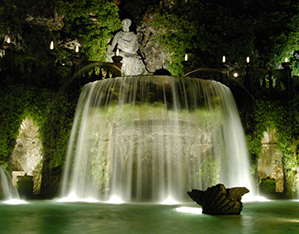Villa d’Este, together with Villa Lante and Caprarola feature the three most famous Renaissance gardens of Lazio and, in the attempt to emulate the nearby Villa Adriana this Villa d’Este is truly unique. For its harmonic combination of Art and Nature and its almost intact original structure, it is a UNESCO World Heritage Site.
We owe this villa to the cultured and refined Cardinal Ippolito d’Este, named governor of Tivoli in 1550 – who intended to revive the splendours of the d’Este golden era and of French courts where he had sojourned – and to his architect and antiquarian Pirro Ligorio. Key to understanding this park is the allegorical and obviously celebratory itinerary touching on themes such as Vice and Virtue – references to Ippolito d’Este, identified with the figure of Hercules, and whose emblems can be found just about everywhere in the park. The garden plan is structured on a grille of orthogonal pathways based on a cardo-decumanus crossing. The cardo massimo, the main avenue, coincides with the central loggia of the villa built on two levels: along this path are the Leda Fountain, the Fountain of the Dragons and the Rotonda dei Cipressi. The fountains along the decumani paths are of particular interest, especially the fountain on the path of the Cento Fontane (the Hundred Fountains): prior to the waterways of Bagnaia and Caprarola, this is the first amazing example of a garden water axis, stretching out between the Sibilla or Ovato Fountain and the Rometta Fountain, along the line connecting the two opposite poles of the Tempio della Sibilla Tiburtina and the city of Rome, visible on the horizon. Parallel to this is the Peschiere (fishpond) axis with the spectacular backdrop of the Fontana dell’Organo and its water display. The exceptional availability of water connected to a deviation of the River Aniene (the Estense Canal) permitted the creation of these numerous fountains giving rise to a truly spectacular and symbolic itinerary. Water is omnipresent in the form of spectacular effects, quiet ponds and basins, noisy jets, gurgling cascades, elaborate water features and, thanks to ingenious devices, even birdsong and clamouring firearms sound effects that at present have only partially been restored.





